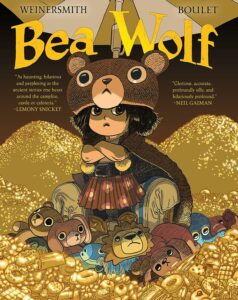Calvin and Hobbes meets the Nickelodeon channel to retell Beowulf in a colorful, creative, graphic novel.
Bea Wolf by Zach Weinersmith & Boulet. First Second, 2023, 208 pages.

Reading Level: Middle Grade, Ages 10-12
Recommended For: Ages 10 and up
If you’ve read, Beowulf, you know it begins with an injunction: “Hwæt”
Open the pages of Bea Wolf and a small, cloaked figured stands, one hand stopping you, dramatically. Above it explodes the words, “Hey, Wait!”
In the way of ancient tale, Bea Wolf begins with recounting heroes. Then it gives a back story. How does one recapture Viking valor in modern parlance? Weinersmith does the unthinkable. . . recasting Vikings as energetic children.
They play, terrorize their parents, find gold, go on tricycle quests, and most of all, they feast on forbidden food (red dye, sugar and candy galore) in their great tree fort in glorious overnight slumber parties.
Ahh, but there is a catch. The tree house abuts the house of the terrible Mr. Grindle: a middle aged man who encapsulates every problem of growing up. Mr. Grindle objects -for some reason- to the treehouse minions tapping his power to fuel their cartoon watching. And so he invades the tree fort, and every child his long, bony fingers touch turns instantly into a grown-up:
Ten kids turned teenaged, tired-eyed, ever-texting
Eight turned middle-aged, aching, anxious, angry at the internet.
All is lost, till one small, determined hero appears on the scene, honoring an old alliance. And so begins more tales, heroes remembered, recounting of our hero’s own heroics, and finally, the ultimate showdown.
If you haven’t gathered, this is a satire. And it’s a retelling of Beowulf. And it’s a graphic novel. And yet, it works. It really works. As a result, Bea Wolf has drawn a plethora of starred reviews. Lemony Snicket and Neil Gaiman have written accolades about it.
Billed a middle-grade novel, I have to say, I think its most appreciative audience will have some knowledge of the original text. (My husband and I would not have laughed quite so hard if we didn’t know exactly what story this one is echoing!)
Weinersmith and Boulet capture the hedonism of Viking culture in the crazy, sugar-fueled antics of young children. Weinersmith’s verses echo the original cadence of Beowulf (his endnotes are well worth reading and he explains different techniques that he uses: alliteration and kennings.) He also captures the high drama of small children, and it all combines for a witty, wild, crazy, and wonderful spin on the tale of Beowulf.
Authority figures aren’t present. But neither is darkness apart from the evil Grindle -and gross teenagers. Disagreements are settled with epic noodle fights. Children scoff sugar and burp and toot and tell potty jokes. (Although the jokes themselves aren’t told, they’re just referenced.)
Children are children … and they aren’t the angelic little creatures that some philosophers posit is a child’s natural condition.
Is this book for everyone? No. I remember once showing an acquaintance a well-loved chapter book, Tales for the Perfect Child. (Spoiler: the children in the book aren’t perfect.) Growing up in a house that valued order and obedience, we children delighted in those stories. They were so funny. Imagine a child who practiced whining and got away with it?
We delighted in the stories because they were fiction, not real. They portrayed a world where the wicked child prospered. And prosper some children do: the wicked child is far more likely to plead for and receive candy than the righteous child who politely accepts the parental “no.” These were stories that understood the world –and laughed at it. Laughed by seriously telling a story about perfect children, who just happen to be illustrated as little monsters … and who were just that. It was a silly book. We loved it, but our acquaintance was horrified.
This is a silly book, too. If you are serious, then the satire might not be for you. But before you worry that this might be a manual for your young child to rebel, remember it is not written for the age of child it portrays. It is written for middle-grade readers, well past the age of pedaling their tricycles off on quests. Would it be helpful for a precocious younger reader, easily influenced by bad behavior in books? That is for you to decide!
However, if you love Beowulf. If you delight in the off-beat humor of Roald Dahl. If you love Calvin and Hobbes. Then this might be the next delightful thing you read!
Considerations:
- Potty Humor (butts, burping, and smooching teens mentioned in passing)
- Worldview (Satirical portrayal of Viking hedonism -see above)
Read more about our ratings here.
Related Reading From Redeemed Reader
- A Review: Kid Beowulf by Alexis Fajarda
- A Resource: Beowulf: Legend, Worldview, and Contemporary Narratives
- A Reflection: Reading Roald Dahl Redemptively: Two Thoughts (principles for Bea Wulf, too!)
We are participants in the Amazon LLC affiliate program; purchases you make through affiliate links like the one below may earn us a commission. Read more here.
Support our writers and help keep Redeemed Reader ad-free by joining the Redeemed Reader Fellowship.
Stay Up to Date!
Get the information you need to make wise choices about books for your children and teens.
Our weekly newsletter includes our latest reviews, related links from around the web, a featured book list, book trivia, and more. We never sell your information. You may unsubscribe at any time.
We'd love to hear from you!
Our comments are now limited to our members (both Silver and Golden Key). Members, you just need to log in with your normal log-in credentials!
Not a member yet? You can join the Silver Key ($2.99/month) for a free 2-week trial. Cancel at any time. Find out more about membership here.

